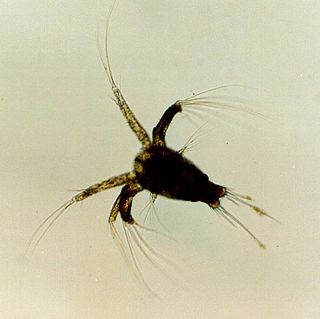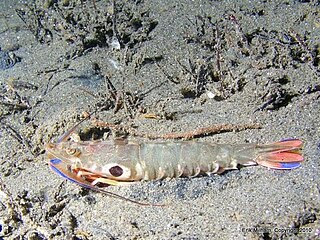
The Decapoda or decapods are an order of crustaceans within the class Malacostraca, including many familiar groups, including crabs, lobsters, crayfish, shrimp, and prawns. Most decapods are scavengers. The order is estimated to contain nearly 15,000 species in around 2,700 genera, with around 3,300 fossil species. Nearly half of these species are crabs, with the shrimp and Anomura including hermit crabs, porcelain crabs, squat lobsters making up the bulk of the remainder. The earliest fossils of the group date to the Devonian.

The Achelata is an infra-order of the decapod crustaceans, holding the spiny lobsters, slipper lobsters and their fossil relatives.

Squat lobsters are dorsoventrally flattened crustaceans with long tails held curled beneath the cephalothorax. They are found in the two superfamilies Galatheoidea and Chirostyloidea, which form part of the decapod infraorder Anomura, alongside groups including the hermit crabs and mole crabs. They are distributed worldwide in the oceans, and occur from near the surface to deep sea hydrothermal vents, with one species occupying caves above sea level. More than 900 species have been described, in around 60 genera. Some species form dense aggregations, either on the sea floor or in the water column, and a small number are commercially fished.
Homeryon is a genus of blind, deep-sea crustaceans. It is named after the blind Greek poet Homer and the genus Eryon, which contains fossil relatives of the modern Polychelidae. It was separated from the genus Polycheles in 2001, and contains only two species.

Acanthacaris is a genus of deep-water lobsters. It contains two species, A. caeca and A. tenuimana, and is the only genus in the subfamily Neophoberinae.

Polychelida is an infraorder of decapod crustaceans. Fossil representatives are known dating from as far back as the Upper Triassic. A total of 38 extant species, all in the family Polychelidae, and 55 fossil species have been described.

Munidopsis is a genus of squat lobster. It is the second largest of all the genera of squat lobsters, after Munida, with over 200 species. Its members are mainly found on continental slopes and on abyssal plains. A few fossil species are also known, including specimens from the Campanian (Cretaceous).

Munida is the largest genus of squat lobsters in the family Munididae, with over 240 species.

Polycheles typhlops is a species of blind, deep water decapod crustacean with a cosmopolitan distribution. It is "one of the dominant and most characteristic crustaceans in deep-sea communities of the Mediterranean Sea".
Cardus crucifer is a species of blind deep-water decapod crustacean from the Atlantic Ocean, the only species in the genus Cardus. It differs from other members of the family Polychelidae in having only four pairs of claws, instead of five, in both sexes. The name Cardus refers to the thistle Carduus, in reference to the spiny thistle-like carapace. It is found in the eastern Atlantic from Portugal to Morocco and around the Azores and Canary Islands, and in the Bahamas, the Caribbean Sea and the Gulf of Mexico, at depths of 550–2,200 metres (1,800–7,220 ft).

Stereomastis sculpta is a species of "strange, blind crustacean" resembling a prawn or a squat lobster. It has a cosmopolitan distribution in deep water, being found on both sides of the Atlantic Ocean, in the Mediterranean Sea, and across much of the Indo-West Pacific, at depths of 200–4,000 metres (660–13,120 ft).

Benthesicymus is a genus of prawns, containing the following species:

Eryonidae is a family of fossil decapod crustaceans which lived from the Upper Triassic to the Lower Cretaceous. It contains four genera: An aggregation of three unidentified eryonids was reported in 2012 inside a Late Jurassic ammonoid of the species Harpoceras falciferum; they represent the earliest evidence of gregarious behaviour in decapods.

Crustaceans may pass through a number of larval and immature stages between hatching from their eggs and reaching their adult form. Each of the stages is separated by a moult, in which the hard exoskeleton is shed to allow the animal to grow. The larvae of crustaceans often bear little resemblance to the adult, and there are still cases where it is not known what larvae will grow into what adults. This is especially true of crustaceans which live as benthic adults, more-so than where the larvae are planktonic, and thereby easily caught.

Uroptychus is a genus of squat lobsters in the family Chirostylidae found across the Indo-Pacific. The genus Uroptychus contains the following species:

Leucosiidae is a family of crabs containing three subfamilies and a number of genera incertae sedis:

Sicyonia is a genus of prawns, placed in its own family, Sicyoniidae. It differs from other prawns in that the last three pairs of its pleopods are uniramous, rather than biramous as seen in all other prawns.
Stereomastis suhmi, the blind lobster, is a species of crustacean resembling a prawn or a squat lobster. It was first described by Charles Spence Bate in 1878.

Polycheles is a genus of decapods within the family Polychelidae, with 9 current species assigned to it. Members of this genus are found in oceans worldwide at depths of 665 to 938 meters.















